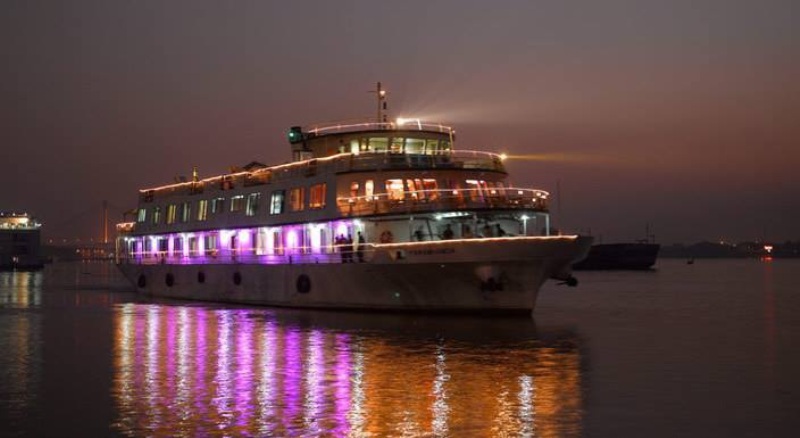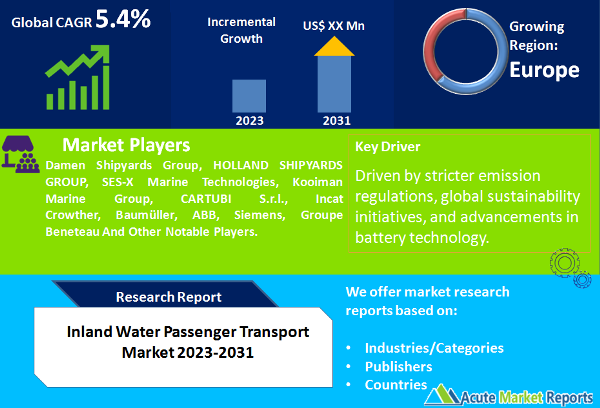
The inland water passenger transport market primarily focuses on the transportation of passengers via freshwater routes such as rivers, lakes, and canals. This form of transportation has historically been crucial for cities and civilizations that developed along freshwater sources. From traditional ferries to luxurious river cruises, the sector offers a wide variety of services. While road and air transport have dominated in recent decades, there's a resurgent interest in inland water passenger transport due to its unique advantages and the challenges faced by other modes of transportation. Here, we delve into the drivers propelling this resurgence and a notable restraint affecting its growth. Inland water passenger transport market is estimated to grow at a CAGR of 5.4% from 2026 to 2034, driven primarily by its environmental benefits, economic advantages, and safety features.

Environmental Sustainability and Efficiency
Lower Carbon Footprint: Inland water transport is notably more fuel-efficient than road or air transport. A single barge, for example, can carry the same amount of cargo as several trucks, resulting in reduced greenhouse gas emissions per ton-mile. As global concerns about climate change escalate, countries are exploring greener transportation alternatives. Inland waterways, being energy-efficient, offer a solution that aligns with sustainability goals. Reduced Road Congestion: Major cities worldwide are grappling with traffic congestion and its resultant air pollution. Promoting waterway transport can significantly alleviate road congestion. For instance, in places like Venice or Amsterdam, water taxis and boats play a vital role in decongesting roads and providing efficient transit.
Economic Advantages for Local Communities
Waterways, especially in scenic areas, attract tourists. River cruises in Europe, like those along the Danube or the Rhine, have become immensely popular, providing an economic boost to the regions they traverse. Similarly, boat rides in Kerala's backwaters in India have spurred local tourism, generating revenue and creating jobs. Waterway stations or stops can become commercial hubs. As seen in cities with active waterways, local markets, eateries, and other businesses tend to flourish around these hubs, infusing economic vitality into the area.
Safety and Comfort
Waterways often boast a lower accident rate compared to road transport. With lesser congestion and the absence of head-on traffic, waterway transport presents fewer possibilities for collisions. River cruises or boat rides offer spacious and comfortable seating compared to buses or trams. Passengers can enjoy scenic views, making their journey not just a mode of transit but also an experience in itself.
Infrastructure Development and Maintenance Costs
High Initial Investment: While waterways promise several benefits, developing the necessary infrastructure, including ports, terminals, and vessels, requires substantial initial investment. Dredging, ensuring navigability, and establishing safety protocols further add to the costs. Regular maintenance of waterway infrastructure can be expensive. Silting, a natural process in many rivers, necessitates frequent dredging to maintain depth for vessel movement. Additionally, the wear and tear of terminals and the need to upgrade vessels to meet environmental or safety standards can impose significant recurrent costs.
Water Taxis Dominate the Market by Vessel Type
In 2025, the inland water passenger transport market, when segmented by vessel type, showcased prominent roles of both Water Taxis and Cruise Ships. Water Taxis, due to their frequent and essential services in cities located near water bodies, accounted for a significant portion of the revenue. They became indispensable, especially in areas where bridges were scarce, or road traffic posed severe challenges. In contrast, Cruise Ships, with their luxury offerings and extended travel durations, were associated with higher ticket prices and onboard expenditures, making them the highest revenue earners in the segment. The demand for specialized experiences, coupled with the allure of river cruises in historically rich and scenic locales, strengthened their revenue position. However, the adaptability and ubiquity of Water Taxis led them to register the highest Compound Annual Growth Rate (CAGR). The growing urban populations in waterfront cities and the increasing preference for quick waterway commutes contributed to this trend.
Conventional propulsion Dominates the Market by Propulsion Methods
Diving into propulsion methods, 2026 marked significant strides in sustainable technologies. Conventional propulsion, primarily using diesel engines, continued to generate the highest revenue, given its widespread use and historical dominance. However, the Electric propulsion segment saw the highest CAGR. Factors driving this trend included stricter emission norms, global sustainability drives, and advancements in battery technology. While Hydrogen and Hybrid methods were also in use, they lagged in terms of broad-based adoption, primarily due to infrastructure challenges and technology maturity concerns. Yet, from 2026 to 2034, as clean energy becomes an undeniable global focus, Electric, Hydrogen, and Hybrid propulsion systems are expected to see considerable growth, with electric maintaining its lead in CAGR due to its current momentum.
Europe emerged as the region with the highest revenue
On the geographic front, in 2025, Europe emerged as the region with the highest revenue percent, buoyed by its intricate waterways, historical river routes, and the popularity of river cruises along iconic rivers like the Danube, Seine, and Rhine. However, the Asia-Pacific region, characterized by its dense urban waterfront cities and growing tourism sectors, recorded the highest CAGR. Countries like Thailand, India, and Vietnam, with their extensive river networks and burgeoning tourism, contributed to this growth. The forecast for 2026 to 2034 anticipates this trend to persist, with the Asia-Pacific potentially expanding its market share, riding on its massive population, urbanization trends, and strategic government initiatives promoting inland water transport.
Competitive Landscape
From a competitive standpoint, 2026 witnessed fierce strategies by key market players such as Damen Shipyards Group, HOLLAND SHIPYARDS GROUP, SES-X Marine Technologies, Kooiman Marine Group, CARTUBI S.r.l., Incat Crowther, Baumüller, ABB, Siemens, Groupe Beneteau. These entities, seeking to solidify their market positions, resorted to fleet expansions, technological advancements in vessel efficiency, and enhanced onboard amenities for passengers. Collaborations with local authorities and strategic partnerships with tech companies, especially in the propulsion segment, also became evident. Emphasis on sustainability, both in vessel operation and passenger experience, became a unique selling proposition. From 2026 to 2034, the market is expected to observe intensified competition, with companies vying for technological supremacy, especially in propulsion systems, and tailoring experiences to attract a broader demographic, ensuring continued market growth.
Historical & Forecast Period
This study report represents analysis of each segment from 2024 to 2034 considering 2025 as the base year. Compounded Annual Growth Rate (CAGR) for each of the respective segments estimated for the forecast period of 2026 to 2034.
The current report comprises of quantitative market estimations for each micro market for every geographical region and qualitative market analysis such as micro and macro environment analysis, market trends, competitive intelligence, segment analysis, porters five force model, top winning strategies, top investment markets, emerging trends and technological analysis, case studies, strategic conclusions and recommendations and other key market insights.
Research Methodology
The complete research study was conducted in three phases, namely: secondary research, primary research, and expert panel review. key data point that enables the estimation of Inland Water Passenger Transport market are as follows:
Market forecast was performed through proprietary software that analyzes various qualitative and quantitative factors. Growth rate and CAGR were estimated through intensive secondary and primary research. Data triangulation across various data points provides accuracy across various analyzed market segments in the report. Application of both top down and bottom-up approach for validation of market estimation assures logical, methodical and mathematical consistency of the quantitative data.
| ATTRIBUTE | DETAILS |
|---|---|
| Research Period | 2024-2034 |
| Base Year | 2025 |
| Forecast Period | 2026-2034 |
| Historical Year | 2024 |
| Unit | USD Million |
| Segmentation | |
Vessel
|
|
Propulsion
|
|
Transportation Mode
|
|
|
Region Segment (2024-2034; US$ Million)
|
Key questions answered in this report